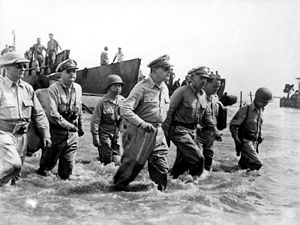การทัพฟิลิปปินส์ (ค.ศ. 1944–1945)
บทความนี้อาจต้องการตรวจสอบต้นฉบับ ในด้านไวยากรณ์ รูปแบบการเขียน การเรียบเรียง คุณภาพ หรือการสะกด คุณสามารถช่วยพัฒนาบทความได้ |
การทัพฟิลิปปินส์, ยุทธการที่ฟิลิปปินส์ หรือการปลดปล่อยฟิลิปปินส์(Filipino: Kampanya sa Pilipinas, Labanan sa Pilipinas & Liberasyon ng Pilipinas), (ปฏิบัติการทหารเสือที่ 1, 2, และ 3) (Filipino: Operasyon Mosketero I, II, at III), เป็นการทัพของสหรัฐและฟิลิปปินส์เพื่อที่จะเอาชนะและขับไล่กองทัพจักรวรรดิญี่ปุ่นที่ยึดครองฟิลิปปินส์ในช่วงสงครามโลกครั้งที่สอง กองทัพบกญี่ปุ่นได้เข้ายึดครองฟิลิปปินส์เอาไว้ทั้งหมดในช่วงครึ่งแรกของปี ค.ศ. 1942 การปลดปลดปล่อยฟิลิปปินส์ได้เริ่มต้นขึ้นด้วยการยกพลขึ้นบกที่เกาะเลเตย์ ทางด้านตะวันออกของฟิลิปปินส์ เมื่อวันที่ 20 ตุลาคม ค.ศ. 1944 กองทัพสหรัฐและเครือจักรภพ ฟิลิปปินส์ได้มีความคืบหน้าในการปลดปล่อนดินแดนและเกาะต่างๆ เมื่อกองทัพญี่ปุ่นในฟิลิปปินส์ได้รับคำสั่งให้ยอมจำนนจากกรุงโตเกียว เมื่อวันที่ 15 สิงหาคม ค.ศ. 1945 ภายหลังจากการทิ้งระเบิดปรมาณูบนแผ่นดินใหญ่ของญี่ปุ่นและโซเวียตบุกครองแมนจูเรีย
อ้างอิง
แก้- ↑ "World War II: Mexican Air Force Helped Liberate the Philippines". History.net. June 12, 2006. สืบค้นเมื่อ June 12, 2015.
- ↑ Schmidt 1982[ลิงก์เสีย]. Retrieved October 22, 2015.
- ↑ Chapter 11: Operations of the Eighth Army in the Central and Southern Philippines, pp. 358 เก็บถาวร 2020-06-03 ที่ เวย์แบ็กแมชชีน. Retrieved March 10, 2016
- ↑ Hunt, Ray C.; Bernard Norling (2000). Behind Japanese Lines: An American Guerrilla in the Philippines. University Press of Kentucky. p. 107. ISBN 978-0-8131-0986-2. สืบค้นเมื่อ February 24, 2011.
- ↑ Stein Ugelvik Larsen, Fascism Outside Europe, Columbia University Press, 2001, p. 785
- ↑ Smith, Triumph in the Philippines Appendix H
- ↑ Cannon, Leyte: Return to the Philippines, pp. 368–369
- ↑ Smith, Triumph in the Philippines, pp. 692–693
- ↑ 9.0 9.1 9.2 Tucker, Spencer (2012). Almanac of American Military History, Vol. 1. ABC-CLIO. p. 1668. ISBN 978-1-59-884530-3.
- ↑ "Triumph in the Philippines" pp. 48 & 66 เก็บถาวร 2016-12-24 ที่ เวย์แบ็กแมชชีน. Retrieved October 26, 2015
- ↑ "Luzon" เก็บถาวร 2016-05-06 ที่ เวย์แบ็กแมชชีน 93,400 non-combat casualties on Luzon alone. Retrieved October 26, 2015
- ↑ 12.0 12.1 "Triumph in the Philippines" pp. 48–66 เก็บถาวร 2016-12-24 ที่ เวย์แบ็กแมชชีน. Retrieved October 26, 2015
- ↑ According to the National World War II Museum, Filipino military deaths during the war numbered 57,000. A significant portion must have fallen in the 1944–45 campaign.
- ↑ Final report, progress of demobilization of the Japanese Armed Forces, Part III: Overseas Areas and IV: Air Forces enclosure #44 เก็บถาวร 2016-01-05 ที่ เวย์แบ็กแมชชีน. Retrieved March 10, 2016. With 109,890 Japanese military personnel repatriated immediately after the war, that leaves around 419,912 Japanese dead, missing, or still holding out.
- ↑ American Battles and Campaigns: A Chronicle from 1622 to 2010 by Chris McNab, p. 184.
- ↑ American Historical Association: Lessons from Iwo Jima. Retrieved November 13, 2015.
- ↑ Includes deaths among wounded but excludes nonbattle deaths; total battle casualties amounted to 60,717. Subtotals are: Luzon: 8,310 killed and 29,560 wounded,[6] Leyte: 3,593 dead/missing and 11,991 wounded,[7] Other: 2,070 dead and 6,990 wounded[8]
- ↑ 3,800 casualties at Leyte Gulf,[9] 2,680 naval casualties in the month after December 13, 1944, and 790 lost in a typhoon[10]
